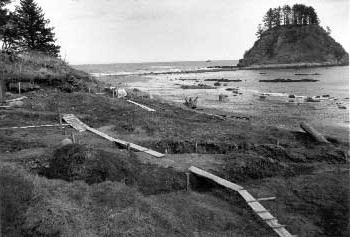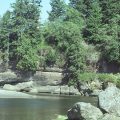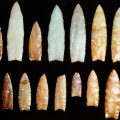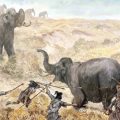
The Makah, whose traditional homeland is on the Olympic Peninsula in the state of Washington, are the western-most Indian nation in the lower forty-eight states of the United States. The name “Makah,” given to this tribe by the neighboring S’Klallam, refers to the generosity of their feasts. The Makah name for themselves means “People Who Live by the Rocks and Seagulls.” Linguistically and culturally, the Makah are related to the Native peoples on Vancouver Island, British Columbia.
The Makah village of Ozette is located at the westernmost point of the Olympic Peninsula. The village was established about 50 CE at a prime location for intercepting migrating gray whales as well as fur seals and Steller sea lions. The Makah were a whaling people and the archaeological findings from Ozette show that 75% of the meat and oil came from whales. Northern fur seals were also important.
In 1700, an earthquake along the Pacific coast triggered a mudslide which covered Ozette. Five houses, one of which was unoccupied, were buried. Journalist Ruth Kirk and archaeologist Richard Daugherty, in their book Archaeology in Washington, write: “The Ozette houses were large—60-70 feet long and about 35 feet wide, dimensions typical of Northwest Coast houses and like them built of plants split from cedar logs and lashed to a framework of upright cedar posts.”
The cedar planks used in the walls were up to 2 1/2 feet wide. The wall planks were smoothed with an adze and some were incised with whale, thunderbird, and wolf motifs. Each house was occupied by six to ten individual families and visiting relatives. James Swan spent time with the Makah in 1859 and remarks of their houses: “They are very comfortable dwellings, and contain several families each. Every family has its separate fire, the smoke of which serves not only to dry the fish and blubber suspended over it, but causes an intense smarting to the eyes of the visitors who are unaccustomed to its acrid fumes.”
Ruth Kirk and Richard Daugherty describe the Ozette houses this way: “Each family had its own living area, readily detectable because of separate cooking hearths. Raised platforms ringed the living space, serving as beds and for storage.”
In 1970, a storm and tidal erosion began to uncover the remains of Ozette. As hikers from the nearby Olympic National Park were walking away with valuable artifacts, The Makah Tribe decided that the site had be to scientifically excavated and tribal chairman Ed Claplanhoo called archaeologist Richard Daugherty at Washington State University and asked him to reopen the archaeological investigation at the site. For the next 11 years, archaeologists from Washington State University working with the Makah recovered more than 55,000 artifacts. Many people feel that this was one of the most important archaeological digs in North America, not only because of the artifacts uncovered, but also because of the involvement of the Makah people in the process. Ruth Kirk and Richard Daugherty report: “Makah students took part in the fieldwork and the preservation of artifacts; Makah elders visited the site and shared memories and information regarding various objects.”
With regard to the agreement between the Makah and the archaeologists, Patricia Erickson, in her book Voices of a Thousand People: The Makah Cultural & Research Center, reports: “No artifacts would leave the physical jurisdiction of the tribe to be displayed, nor would any prehistoric loss of life associated with the Ozette mudslide be mentioned publicly, if any were discovered.”
The Makah site is what archaeologists call a “wet site” in which the mud which covered the village also served to protect organic material from decay by sealing out the air. As a result, the archaeologists were able to recover things like a piece of a dog-wool blanket and a braid of human hair.
Most prehistoric archaeological sites in North America are places which were abandoned by the Indian people who had lived there. As a result, archaeologists have to interpret daily life by the trash that people left behind. Ozette, however, is more like Pompeii in Italy in that the mudslide covered up a living village giving the archaeologists a glimpse of the daily lives of the people.
Once archaeologists have dug a site, the next task includes preserving the artifacts, interpreting what they mean, and then displaying them to the public. For most archaeological sites in the United States, this means transporting the artifacts to a distant museum or university where non-Indian people take over the tasks of interpreting meaning and displaying the artifacts to the public. In the nineteenth century the emphasis was on displaying artifacts, but this has changed: most museums over the past fifty years or so want to explain the artifacts to the public, to use them in telling a story. The story, however, is often a non-Indian view of the American Indian past. Patricia Erickson, in her book Voices of a Thousand People: The Makah Cultural & Research Center, writes: “In the history of the United States, and of many European societies, the museum has been one of the places where particular versions of knowledge have been legitimated and others have been categorized as primitive folklore or myth.”
The Makah did not want their heritage sent to a distant facility: they wanted to retain it on their own reservation so that their children, grandchildren, and great-grandchildren would be able to understand their own past and the teachings of the elders. In 1979 the tribe opened the Makah Cultural and Research Center to house the artifacts from the archaeological excavation at Ozette. The museum is more than a display of artifacts for tourists: it is intended to inform and educate the community about the ancestral Makah. It is about remembering ancestors, traditions, language, and values.
With regard to language, museum collections have been traditionally arranged and indexed with regard to material culture which would include categories such as containers, hunting gear, and so on. However, in the development of the Makah museum it was soon realized that these categories were English language cognitive categories. Thus the collection was organized on the basis of Makah cognitive categories instead of English categories. Patricia Erickson reports: “Makah conceptual categories became used not only for organizing the collection but also for stimulating reflection on Makah worldviews codified in their language.” Bilingual labels are used in the Museum’s displays.
Today, the Makah Cultural and Research Center is one of more than 100 tribal museums in the United States (there are also about 50 in Canada). About 20,000 non-Makah visitors per year get to see and experience the Makah heritage and the materials from Ozette.




Leave a Reply